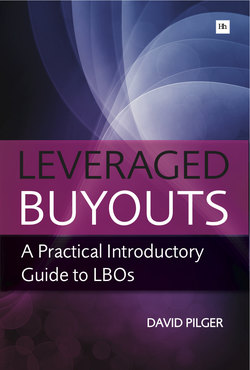Оглавление
David Pilger. Leveraged Buyouts
Publishing details
About the Author
Preface. What this book is about
Who this book is for
What knowledge is assumed
Chapter 1: What Is An LBO?
Chapter 2: Leveraged Buyouts: The Purpose
Advantages of Leverage
Bigger is possible
Limited losses
Reduced taxes
Risks of Leverage
Outcomes
Positive outcome
Negative outcome
Chapter 3: Players in a Leveraged Buyout. Investor
Lenders – Senior Bank Debt
Debt investors – high yield
Current owners – sellers
Existing creditors
Chapter 4: Anatomy of a Practitioner’s Analysis. Overview of Financial Statements
Balance sheet
Income statement
Cash flow statement
Debt sweep
Application of Financial Statements
Income statement
Balance sheet
Cash flow statement
Debt sweep
Ratio analysis
LBO Analysis. Goals of LBO analysis
Cash in hand
Feeling sensitive
Steps in Creating an LBO Analysis. 1. Determine the sources and uses of funds for the transaction
2. Forecast the pro forma income statement
3. Calculate pro forma cash flow
4. Calculate changes and paydown of leverage via the debt sweep analysis
5. Determine expected returns and multiples of capital
6. Calculate shareholders’ equity and relevant credit ratios and statistics
7. Sensitivity analysis
Part II: Building and Analysis
Chapter 5: How Much and Who’s Paying For It?
Uses of Funds. Price
Sources and uses of cash
Number of shares
Acquisition equity
Net debt
Net debt calculation
Transaction costs
Total use of funds
Sources of Funds
Leveraging Up
Transaction Enterprise Value – Measuring Value
Chapter 6: Income Statement
Income statement
Net revenues
Cost of goods sold (COGS)
Sales, general and administrative expense (SG&A)
Other expenses
Operating income
Future Growth
Chapter 7: Cost Structure. Expenses
Revealing Ratios
COGs-to-revenue ratio
SG&A-to-revenue ratio
Depreciation and amortization-to-revenue ratio
In the Years Ahead
Expense ratios
Chapter 8: Income Statement Forecast
Forecasting Year 1
Extending Our Projections
Checkpoint: Are We Right?
Chapter 9: Interest. Setting the Stage
Taxes
Chapter 10: Ebitda
Chapter 11: Cash Flow
Cash flow and debt sweep analysis
Chapter 12: Outstanding Debt Balance
Paying Down Leverage – How Much is the Right Amount?
Excess Cash
Across the Five Years
Net Interest Income
Statistics and Ratio Analysis
Chapter 13: Return Analysis
IRR analysis
Multiple of Money
Returns in the Future
Chapter 14: Additional Ratio Analysis
Shareholders’ equity
Debt Ratios. Total debt to equity
Ratios analysis
Total debt to capital
Total debt to EBITDA
Coverage Ratios
Chapter 15: Sensitivity Analysis
Sensitivity analysis
Conclusion
Other Business Books by Harriman House. Optimising Distressed Loan Books: Practical solutions for dealing with non-performing loans
Portfolio Representations: A step-by-step guide to representing value, exposure and risk for fixed income, equity, FX and derivatives
The Operational Risk Handbook: A guide to the new world of performance-oriented operational risk
The Ultra High Net Worth Banker’s Handbook
Отрывок из книги
David Pilger is a founder and principal at Flex Banker LLC, a corporate advisory firm focused on providing corporate finance and capital raising advice to growing companies with innovative technologies. Flex Banker focuses on education, Ag-science, alternative energy, and manufacturing/industrial sectors as well as the financial sector. In addition to advising emerging growth companies with game-changing technology, he has been a consultant or advisor to large institutional clients such as Goldman Sachs, Morgan Stanley, and Pepsico to name a few.
David teaches corporate valuation and financial modeling and trains financial industry professionals at top financial institutions such as Paulson & Co., Barclays Capital, and other leading financial institutions at Blue Chip Career advisors.
.....
The creditors have prepared for the day of failure since before the original credit agreements were signed. In the case of a failing business (or bankruptcy), the creditors stand in line ahead of the equity partners to get their money back. Only after all the creditors get their money back is there any chance of equity investors recouping their investment capital and usually by that time there is nothing left to recoup.
If a company were to not have any debt, but were to fall on tough financial times, the outcome would be somewhat different. The biggest difference would be that there would be less chance of bankruptcy. (We are presuming that there are no unsecured creditors like employees or vendors that have supplied goods or services without being paid.) The company could sell any assets it has on its balance sheet. From the proceeds of the asset sale, the equity partners of the company could keep all the money and help stave off bankruptcy.
.....
